Report: Facilitating Change in Health and Social Care Services
VerifiedAdded on 2021/01/02
|19
|5756
|295
Report
AI Summary
This report examines the changes in health and social care (H&SC) services, focusing on a case study of Liverpool Home Care. It analyzes the factors driving these changes, such as modernizing agendas, current legislation (Care Act 2014), and government initiatives, along with the challenges encountered, including incorporating changes into existing services and managing resources. The report evaluates strategies for measuring the impact of these changes, including regulatory inspections, internal quality control systems, and user feedback. It also discusses change management principles and their application within the context of Liverpool Home Care. Furthermore, it assesses methods for monitoring the implemented changes, emphasizing the importance of continuous improvement in training and recruitment to meet the standards set by the Care Quality Commission (CQC). The report concludes with an overview of the overall impact and the need for appropriate service responses to ensure effective H&SC delivery.

Facilitating change in Health
and Social care
and Social care
Paraphrase This Document
Need a fresh take? Get an instant paraphrase of this document with our AI Paraphraser
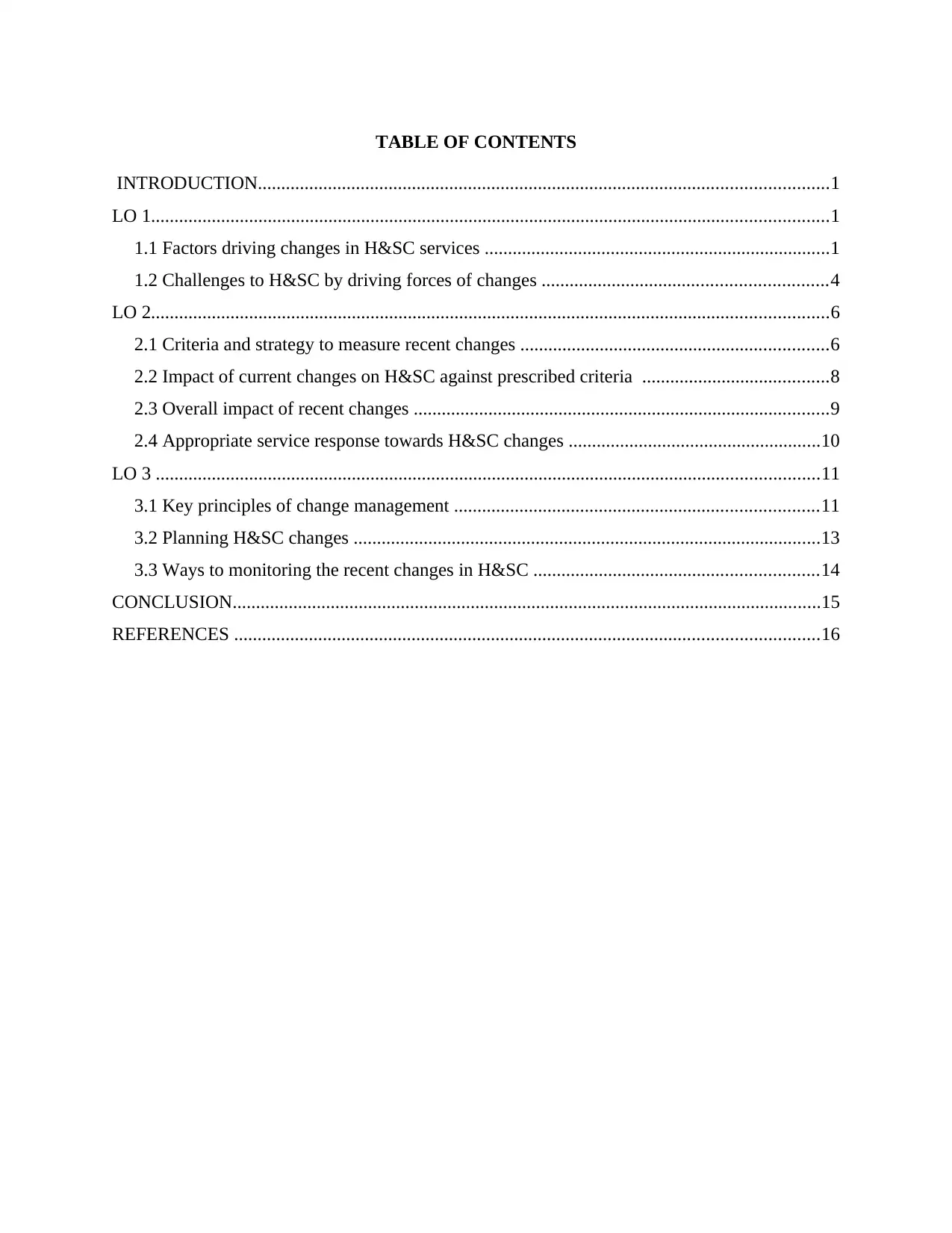
TABLE OF CONTENTS
INTRODUCTION..........................................................................................................................1
LO 1.................................................................................................................................................1
1.1 Factors driving changes in H&SC services ..........................................................................1
1.2 Challenges to H&SC by driving forces of changes .............................................................4
LO 2.................................................................................................................................................6
2.1 Criteria and strategy to measure recent changes ..................................................................6
2.2 Impact of current changes on H&SC against prescribed criteria ........................................8
2.3 Overall impact of recent changes .........................................................................................9
2.4 Appropriate service response towards H&SC changes ......................................................10
LO 3 ..............................................................................................................................................11
3.1 Key principles of change management ..............................................................................11
3.2 Planning H&SC changes ....................................................................................................13
3.3 Ways to monitoring the recent changes in H&SC .............................................................14
CONCLUSION..............................................................................................................................15
REFERENCES .............................................................................................................................16
INTRODUCTION..........................................................................................................................1
LO 1.................................................................................................................................................1
1.1 Factors driving changes in H&SC services ..........................................................................1
1.2 Challenges to H&SC by driving forces of changes .............................................................4
LO 2.................................................................................................................................................6
2.1 Criteria and strategy to measure recent changes ..................................................................6
2.2 Impact of current changes on H&SC against prescribed criteria ........................................8
2.3 Overall impact of recent changes .........................................................................................9
2.4 Appropriate service response towards H&SC changes ......................................................10
LO 3 ..............................................................................................................................................11
3.1 Key principles of change management ..............................................................................11
3.2 Planning H&SC changes ....................................................................................................13
3.3 Ways to monitoring the recent changes in H&SC .............................................................14
CONCLUSION..............................................................................................................................15
REFERENCES .............................................................................................................................16
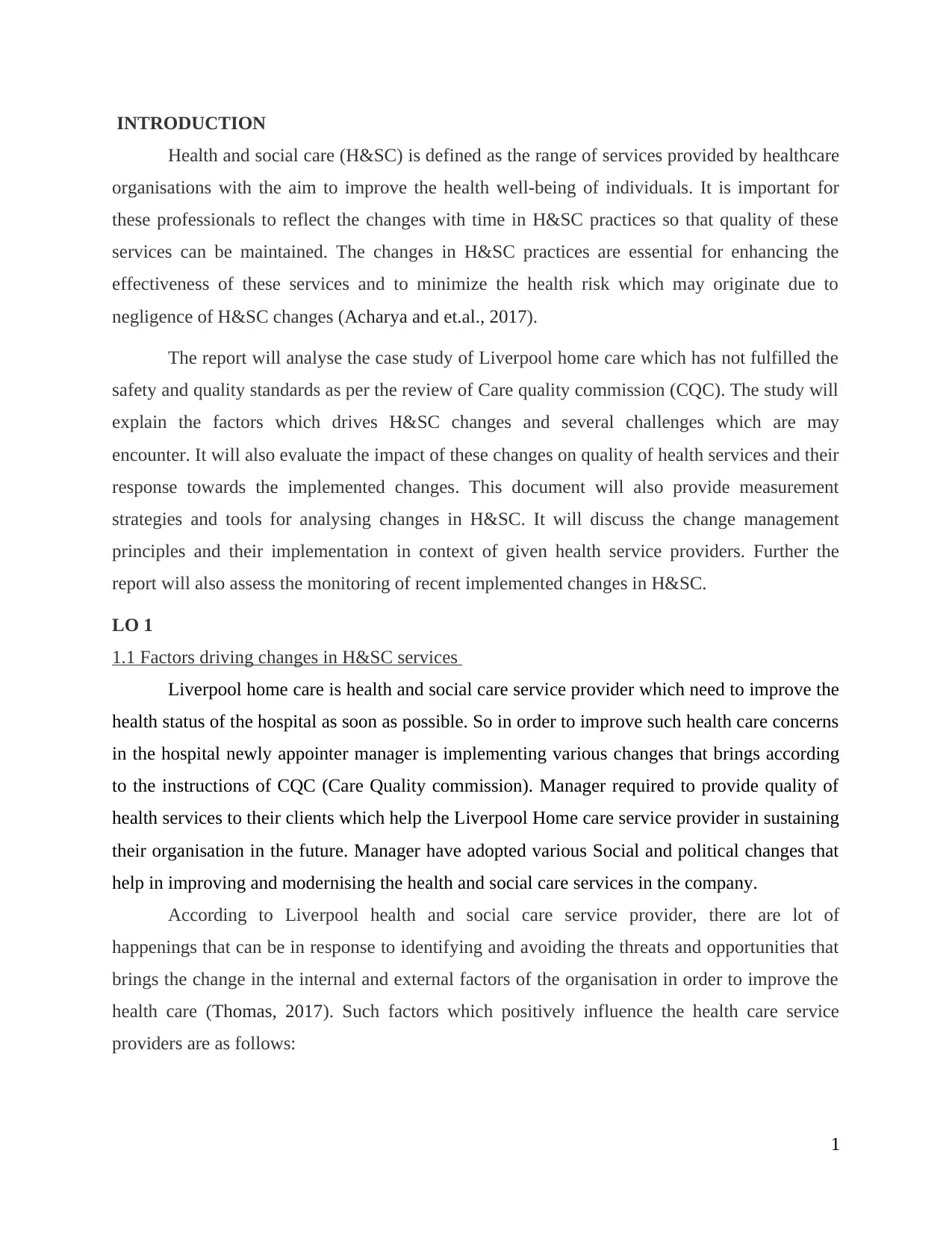
INTRODUCTION
Health and social care (H&SC) is defined as the range of services provided by healthcare
organisations with the aim to improve the health well-being of individuals. It is important for
these professionals to reflect the changes with time in H&SC practices so that quality of these
services can be maintained. The changes in H&SC practices are essential for enhancing the
effectiveness of these services and to minimize the health risk which may originate due to
negligence of H&SC changes (Acharya and et.al., 2017).
The report will analyse the case study of Liverpool home care which has not fulfilled the
safety and quality standards as per the review of Care quality commission (CQC). The study will
explain the factors which drives H&SC changes and several challenges which are may
encounter. It will also evaluate the impact of these changes on quality of health services and their
response towards the implemented changes. This document will also provide measurement
strategies and tools for analysing changes in H&SC. It will discuss the change management
principles and their implementation in context of given health service providers. Further the
report will also assess the monitoring of recent implemented changes in H&SC.
LO 1
1.1 Factors driving changes in H&SC services
Liverpool home care is health and social care service provider which need to improve the
health status of the hospital as soon as possible. So in order to improve such health care concerns
in the hospital newly appointer manager is implementing various changes that brings according
to the instructions of CQC (Care Quality commission). Manager required to provide quality of
health services to their clients which help the Liverpool Home care service provider in sustaining
their organisation in the future. Manager have adopted various Social and political changes that
help in improving and modernising the health and social care services in the company.
According to Liverpool health and social care service provider, there are lot of
happenings that can be in response to identifying and avoiding the threats and opportunities that
brings the change in the internal and external factors of the organisation in order to improve the
health care (Thomas, 2017). Such factors which positively influence the health care service
providers are as follows:
1
Health and social care (H&SC) is defined as the range of services provided by healthcare
organisations with the aim to improve the health well-being of individuals. It is important for
these professionals to reflect the changes with time in H&SC practices so that quality of these
services can be maintained. The changes in H&SC practices are essential for enhancing the
effectiveness of these services and to minimize the health risk which may originate due to
negligence of H&SC changes (Acharya and et.al., 2017).
The report will analyse the case study of Liverpool home care which has not fulfilled the
safety and quality standards as per the review of Care quality commission (CQC). The study will
explain the factors which drives H&SC changes and several challenges which are may
encounter. It will also evaluate the impact of these changes on quality of health services and their
response towards the implemented changes. This document will also provide measurement
strategies and tools for analysing changes in H&SC. It will discuss the change management
principles and their implementation in context of given health service providers. Further the
report will also assess the monitoring of recent implemented changes in H&SC.
LO 1
1.1 Factors driving changes in H&SC services
Liverpool home care is health and social care service provider which need to improve the
health status of the hospital as soon as possible. So in order to improve such health care concerns
in the hospital newly appointer manager is implementing various changes that brings according
to the instructions of CQC (Care Quality commission). Manager required to provide quality of
health services to their clients which help the Liverpool Home care service provider in sustaining
their organisation in the future. Manager have adopted various Social and political changes that
help in improving and modernising the health and social care services in the company.
According to Liverpool health and social care service provider, there are lot of
happenings that can be in response to identifying and avoiding the threats and opportunities that
brings the change in the internal and external factors of the organisation in order to improve the
health care (Thomas, 2017). Such factors which positively influence the health care service
providers are as follows:
1
⊘ This is a preview!⊘
Do you want full access?
Subscribe today to unlock all pages.

Trusted by 1+ million students worldwide
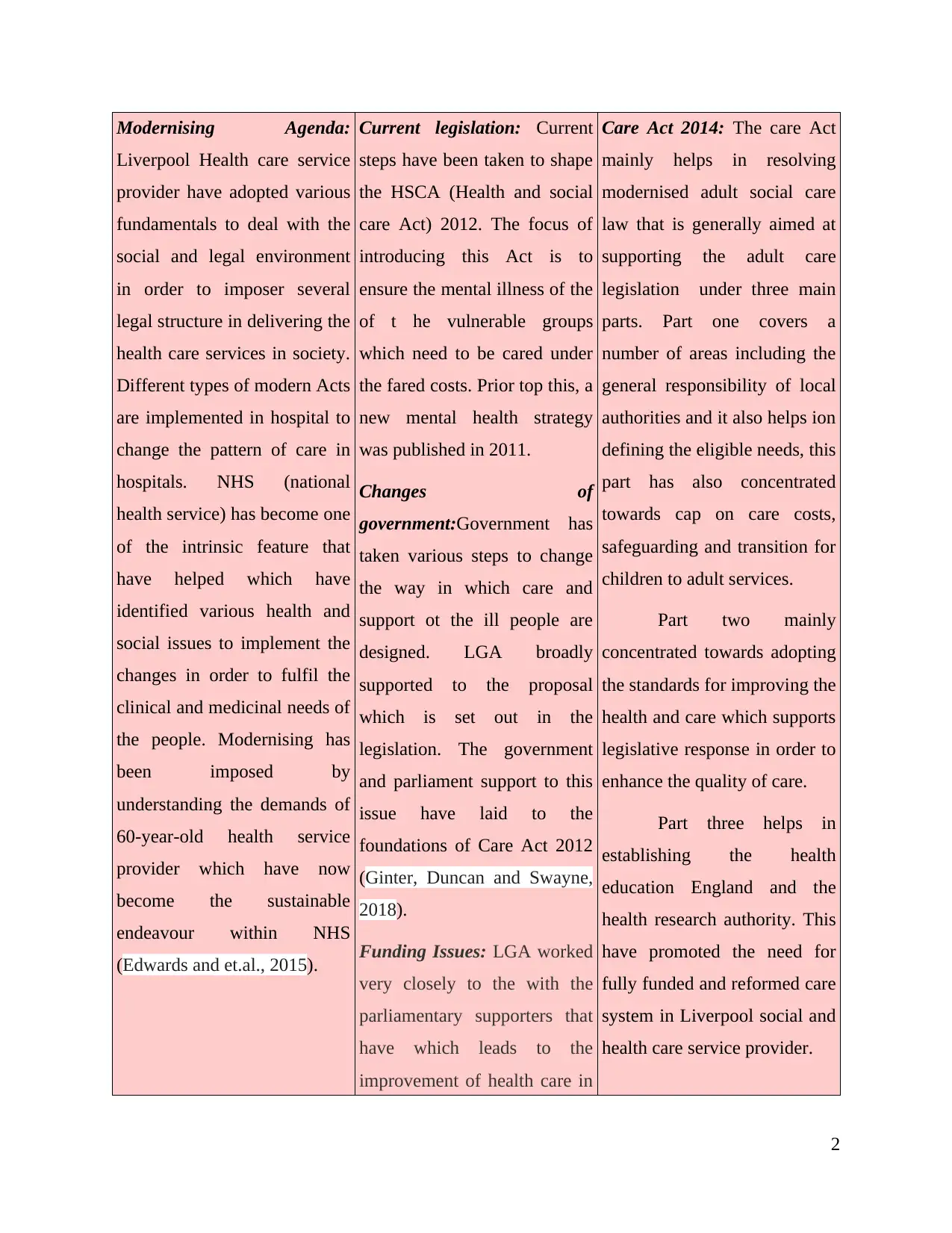
Modernising Agenda:
Liverpool Health care service
provider have adopted various
fundamentals to deal with the
social and legal environment
in order to imposer several
legal structure in delivering the
health care services in society.
Different types of modern Acts
are implemented in hospital to
change the pattern of care in
hospitals. NHS (national
health service) has become one
of the intrinsic feature that
have helped which have
identified various health and
social issues to implement the
changes in order to fulfil the
clinical and medicinal needs of
the people. Modernising has
been imposed by
understanding the demands of
60-year-old health service
provider which have now
become the sustainable
endeavour within NHS
(Edwards and et.al., 2015).
Current legislation: Current
steps have been taken to shape
the HSCA (Health and social
care Act) 2012. The focus of
introducing this Act is to
ensure the mental illness of the
of t he vulnerable groups
which need to be cared under
the fared costs. Prior top this, a
new mental health strategy
was published in 2011.
Changes of
government:Government has
taken various steps to change
the way in which care and
support ot the ill people are
designed. LGA broadly
supported to the proposal
which is set out in the
legislation. The government
and parliament support to this
issue have laid to the
foundations of Care Act 2012
(Ginter, Duncan and Swayne,
2018).
Funding Issues: LGA worked
very closely to the with the
parliamentary supporters that
have which leads to the
improvement of health care in
Care Act 2014: The care Act
mainly helps in resolving
modernised adult social care
law that is generally aimed at
supporting the adult care
legislation under three main
parts. Part one covers a
number of areas including the
general responsibility of local
authorities and it also helps ion
defining the eligible needs, this
part has also concentrated
towards cap on care costs,
safeguarding and transition for
children to adult services.
Part two mainly
concentrated towards adopting
the standards for improving the
health and care which supports
legislative response in order to
enhance the quality of care.
Part three helps in
establishing the health
education England and the
health research authority. This
have promoted the need for
fully funded and reformed care
system in Liverpool social and
health care service provider.
2
Liverpool Health care service
provider have adopted various
fundamentals to deal with the
social and legal environment
in order to imposer several
legal structure in delivering the
health care services in society.
Different types of modern Acts
are implemented in hospital to
change the pattern of care in
hospitals. NHS (national
health service) has become one
of the intrinsic feature that
have helped which have
identified various health and
social issues to implement the
changes in order to fulfil the
clinical and medicinal needs of
the people. Modernising has
been imposed by
understanding the demands of
60-year-old health service
provider which have now
become the sustainable
endeavour within NHS
(Edwards and et.al., 2015).
Current legislation: Current
steps have been taken to shape
the HSCA (Health and social
care Act) 2012. The focus of
introducing this Act is to
ensure the mental illness of the
of t he vulnerable groups
which need to be cared under
the fared costs. Prior top this, a
new mental health strategy
was published in 2011.
Changes of
government:Government has
taken various steps to change
the way in which care and
support ot the ill people are
designed. LGA broadly
supported to the proposal
which is set out in the
legislation. The government
and parliament support to this
issue have laid to the
foundations of Care Act 2012
(Ginter, Duncan and Swayne,
2018).
Funding Issues: LGA worked
very closely to the with the
parliamentary supporters that
have which leads to the
improvement of health care in
Care Act 2014: The care Act
mainly helps in resolving
modernised adult social care
law that is generally aimed at
supporting the adult care
legislation under three main
parts. Part one covers a
number of areas including the
general responsibility of local
authorities and it also helps ion
defining the eligible needs, this
part has also concentrated
towards cap on care costs,
safeguarding and transition for
children to adult services.
Part two mainly
concentrated towards adopting
the standards for improving the
health and care which supports
legislative response in order to
enhance the quality of care.
Part three helps in
establishing the health
education England and the
health research authority. This
have promoted the need for
fully funded and reformed care
system in Liverpool social and
health care service provider.
2
Paraphrase This Document
Need a fresh take? Get an instant paraphrase of this document with our AI Paraphraser
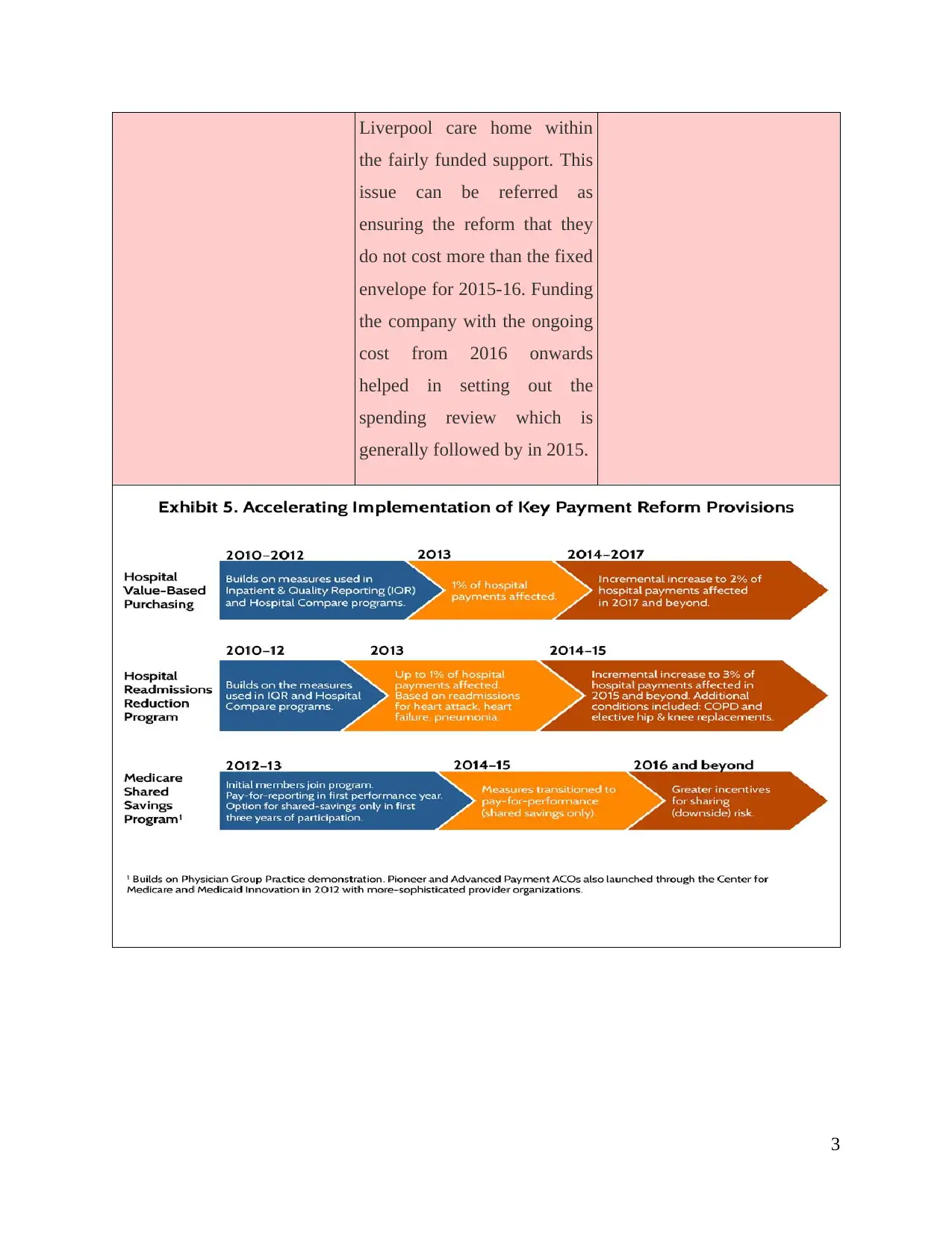
Liverpool care home within
the fairly funded support. This
issue can be referred as
ensuring the reform that they
do not cost more than the fixed
envelope for 2015-16. Funding
the company with the ongoing
cost from 2016 onwards
helped in setting out the
spending review which is
generally followed by in 2015.
3
the fairly funded support. This
issue can be referred as
ensuring the reform that they
do not cost more than the fixed
envelope for 2015-16. Funding
the company with the ongoing
cost from 2016 onwards
helped in setting out the
spending review which is
generally followed by in 2015.
3
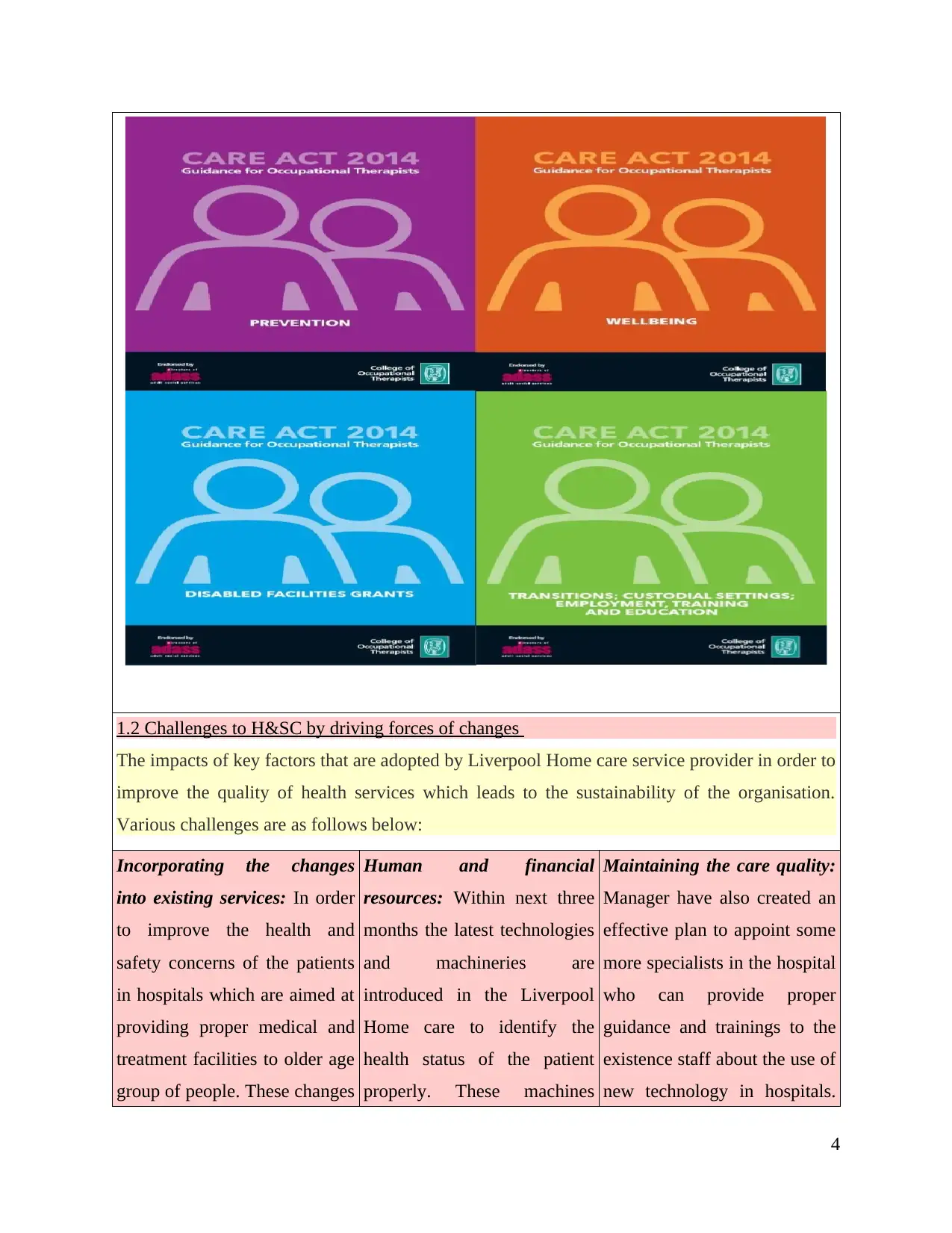
1.2 Challenges to H&SC by driving forces of changes
The impacts of key factors that are adopted by Liverpool Home care service provider in order to
improve the quality of health services which leads to the sustainability of the organisation.
Various challenges are as follows below:
Incorporating the changes
into existing services: In order
to improve the health and
safety concerns of the patients
in hospitals which are aimed at
providing proper medical and
treatment facilities to older age
group of people. These changes
Human and financial
resources: Within next three
months the latest technologies
and machineries are
introduced in the Liverpool
Home care to identify the
health status of the patient
properly. These machines
Maintaining the care quality:
Manager have also created an
effective plan to appoint some
more specialists in the hospital
who can provide proper
guidance and trainings to the
existence staff about the use of
new technology in hospitals.
4
The impacts of key factors that are adopted by Liverpool Home care service provider in order to
improve the quality of health services which leads to the sustainability of the organisation.
Various challenges are as follows below:
Incorporating the changes
into existing services: In order
to improve the health and
safety concerns of the patients
in hospitals which are aimed at
providing proper medical and
treatment facilities to older age
group of people. These changes
Human and financial
resources: Within next three
months the latest technologies
and machineries are
introduced in the Liverpool
Home care to identify the
health status of the patient
properly. These machines
Maintaining the care quality:
Manager have also created an
effective plan to appoint some
more specialists in the hospital
who can provide proper
guidance and trainings to the
existence staff about the use of
new technology in hospitals.
4
⊘ This is a preview!⊘
Do you want full access?
Subscribe today to unlock all pages.

Trusted by 1+ million students worldwide
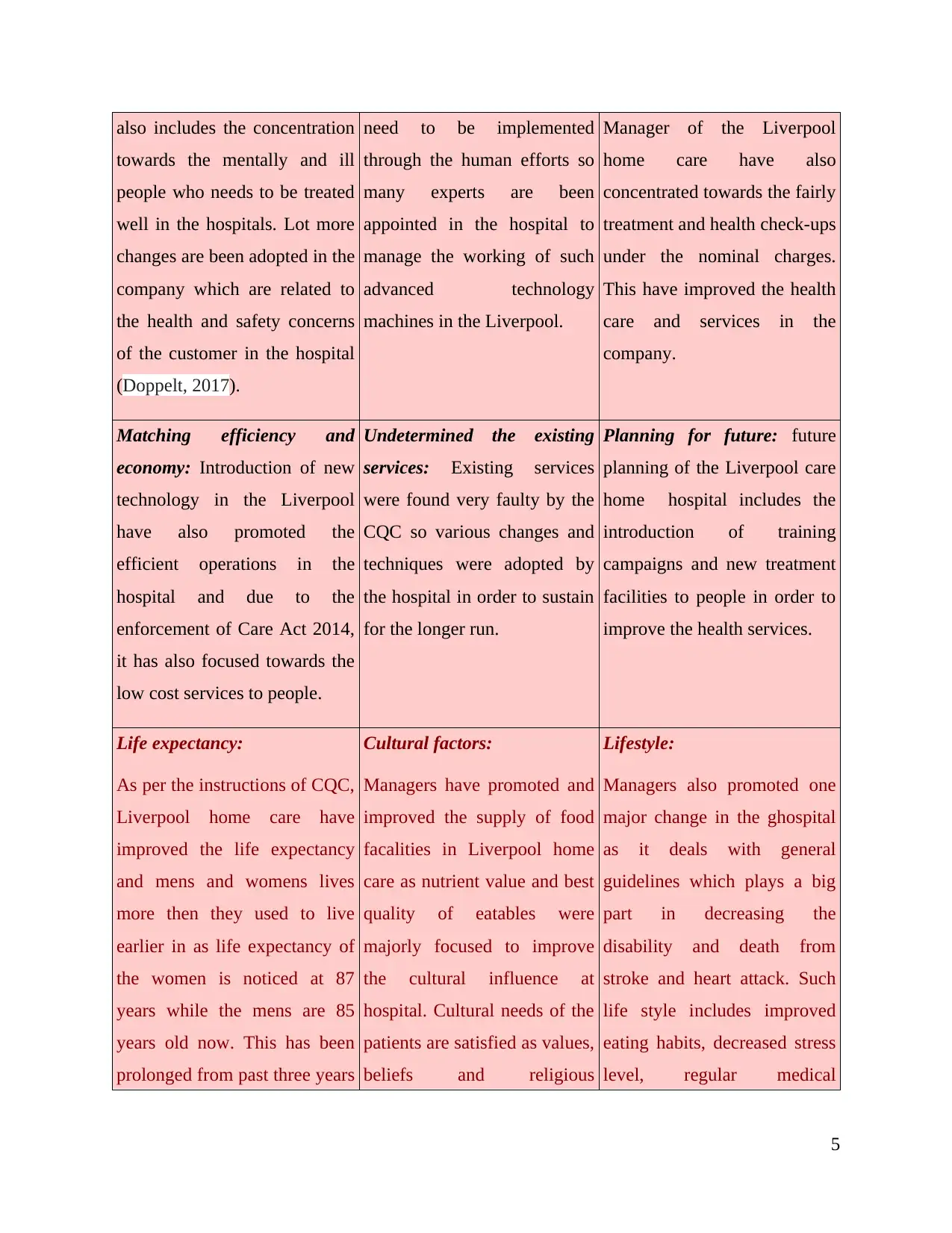
also includes the concentration
towards the mentally and ill
people who needs to be treated
well in the hospitals. Lot more
changes are been adopted in the
company which are related to
the health and safety concerns
of the customer in the hospital
(Doppelt, 2017).
need to be implemented
through the human efforts so
many experts are been
appointed in the hospital to
manage the working of such
advanced technology
machines in the Liverpool.
Manager of the Liverpool
home care have also
concentrated towards the fairly
treatment and health check-ups
under the nominal charges.
This have improved the health
care and services in the
company.
Matching efficiency and
economy: Introduction of new
technology in the Liverpool
have also promoted the
efficient operations in the
hospital and due to the
enforcement of Care Act 2014,
it has also focused towards the
low cost services to people.
Undetermined the existing
services: Existing services
were found very faulty by the
CQC so various changes and
techniques were adopted by
the hospital in order to sustain
for the longer run.
Planning for future: future
planning of the Liverpool care
home hospital includes the
introduction of training
campaigns and new treatment
facilities to people in order to
improve the health services.
Life expectancy:
As per the instructions of CQC,
Liverpool home care have
improved the life expectancy
and mens and womens lives
more then they used to live
earlier in as life expectancy of
the women is noticed at 87
years while the mens are 85
years old now. This has been
prolonged from past three years
Cultural factors:
Managers have promoted and
improved the supply of food
facalities in Liverpool home
care as nutrient value and best
quality of eatables were
majorly focused to improve
the cultural influence at
hospital. Cultural needs of the
patients are satisfied as values,
beliefs and religious
Lifestyle:
Managers also promoted one
major change in the ghospital
as it deals with general
guidelines which plays a big
part in decreasing the
disability and death from
stroke and heart attack. Such
life style includes improved
eating habits, decreased stress
level, regular medical
5
towards the mentally and ill
people who needs to be treated
well in the hospitals. Lot more
changes are been adopted in the
company which are related to
the health and safety concerns
of the customer in the hospital
(Doppelt, 2017).
need to be implemented
through the human efforts so
many experts are been
appointed in the hospital to
manage the working of such
advanced technology
machines in the Liverpool.
Manager of the Liverpool
home care have also
concentrated towards the fairly
treatment and health check-ups
under the nominal charges.
This have improved the health
care and services in the
company.
Matching efficiency and
economy: Introduction of new
technology in the Liverpool
have also promoted the
efficient operations in the
hospital and due to the
enforcement of Care Act 2014,
it has also focused towards the
low cost services to people.
Undetermined the existing
services: Existing services
were found very faulty by the
CQC so various changes and
techniques were adopted by
the hospital in order to sustain
for the longer run.
Planning for future: future
planning of the Liverpool care
home hospital includes the
introduction of training
campaigns and new treatment
facilities to people in order to
improve the health services.
Life expectancy:
As per the instructions of CQC,
Liverpool home care have
improved the life expectancy
and mens and womens lives
more then they used to live
earlier in as life expectancy of
the women is noticed at 87
years while the mens are 85
years old now. This has been
prolonged from past three years
Cultural factors:
Managers have promoted and
improved the supply of food
facalities in Liverpool home
care as nutrient value and best
quality of eatables were
majorly focused to improve
the cultural influence at
hospital. Cultural needs of the
patients are satisfied as values,
beliefs and religious
Lifestyle:
Managers also promoted one
major change in the ghospital
as it deals with general
guidelines which plays a big
part in decreasing the
disability and death from
stroke and heart attack. Such
life style includes improved
eating habits, decreased stress
level, regular medical
5
Paraphrase This Document
Need a fresh take? Get an instant paraphrase of this document with our AI Paraphraser
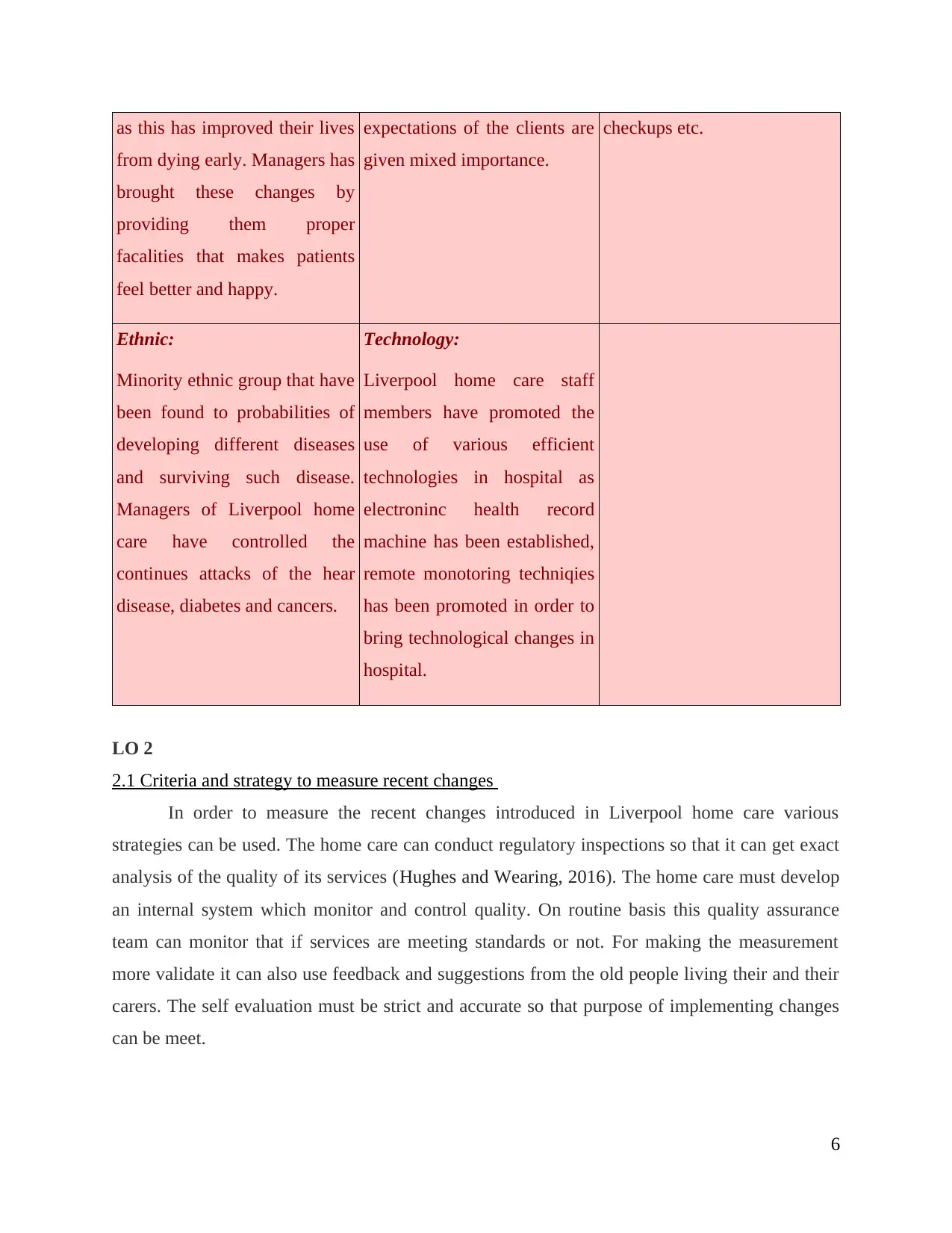
as this has improved their lives
from dying early. Managers has
brought these changes by
providing them proper
facalities that makes patients
feel better and happy.
expectations of the clients are
given mixed importance.
checkups etc.
Ethnic:
Minority ethnic group that have
been found to probabilities of
developing different diseases
and surviving such disease.
Managers of Liverpool home
care have controlled the
continues attacks of the hear
disease, diabetes and cancers.
Technology:
Liverpool home care staff
members have promoted the
use of various efficient
technologies in hospital as
electroninc health record
machine has been established,
remote monotoring techniqies
has been promoted in order to
bring technological changes in
hospital.
LO 2
2.1 Criteria and strategy to measure recent changes
In order to measure the recent changes introduced in Liverpool home care various
strategies can be used. The home care can conduct regulatory inspections so that it can get exact
analysis of the quality of its services (Hughes and Wearing, 2016). The home care must develop
an internal system which monitor and control quality. On routine basis this quality assurance
team can monitor that if services are meeting standards or not. For making the measurement
more validate it can also use feedback and suggestions from the old people living their and their
carers. The self evaluation must be strict and accurate so that purpose of implementing changes
can be meet.
6
from dying early. Managers has
brought these changes by
providing them proper
facalities that makes patients
feel better and happy.
expectations of the clients are
given mixed importance.
checkups etc.
Ethnic:
Minority ethnic group that have
been found to probabilities of
developing different diseases
and surviving such disease.
Managers of Liverpool home
care have controlled the
continues attacks of the hear
disease, diabetes and cancers.
Technology:
Liverpool home care staff
members have promoted the
use of various efficient
technologies in hospital as
electroninc health record
machine has been established,
remote monotoring techniqies
has been promoted in order to
bring technological changes in
hospital.
LO 2
2.1 Criteria and strategy to measure recent changes
In order to measure the recent changes introduced in Liverpool home care various
strategies can be used. The home care can conduct regulatory inspections so that it can get exact
analysis of the quality of its services (Hughes and Wearing, 2016). The home care must develop
an internal system which monitor and control quality. On routine basis this quality assurance
team can monitor that if services are meeting standards or not. For making the measurement
more validate it can also use feedback and suggestions from the old people living their and their
carers. The self evaluation must be strict and accurate so that purpose of implementing changes
can be meet.
6
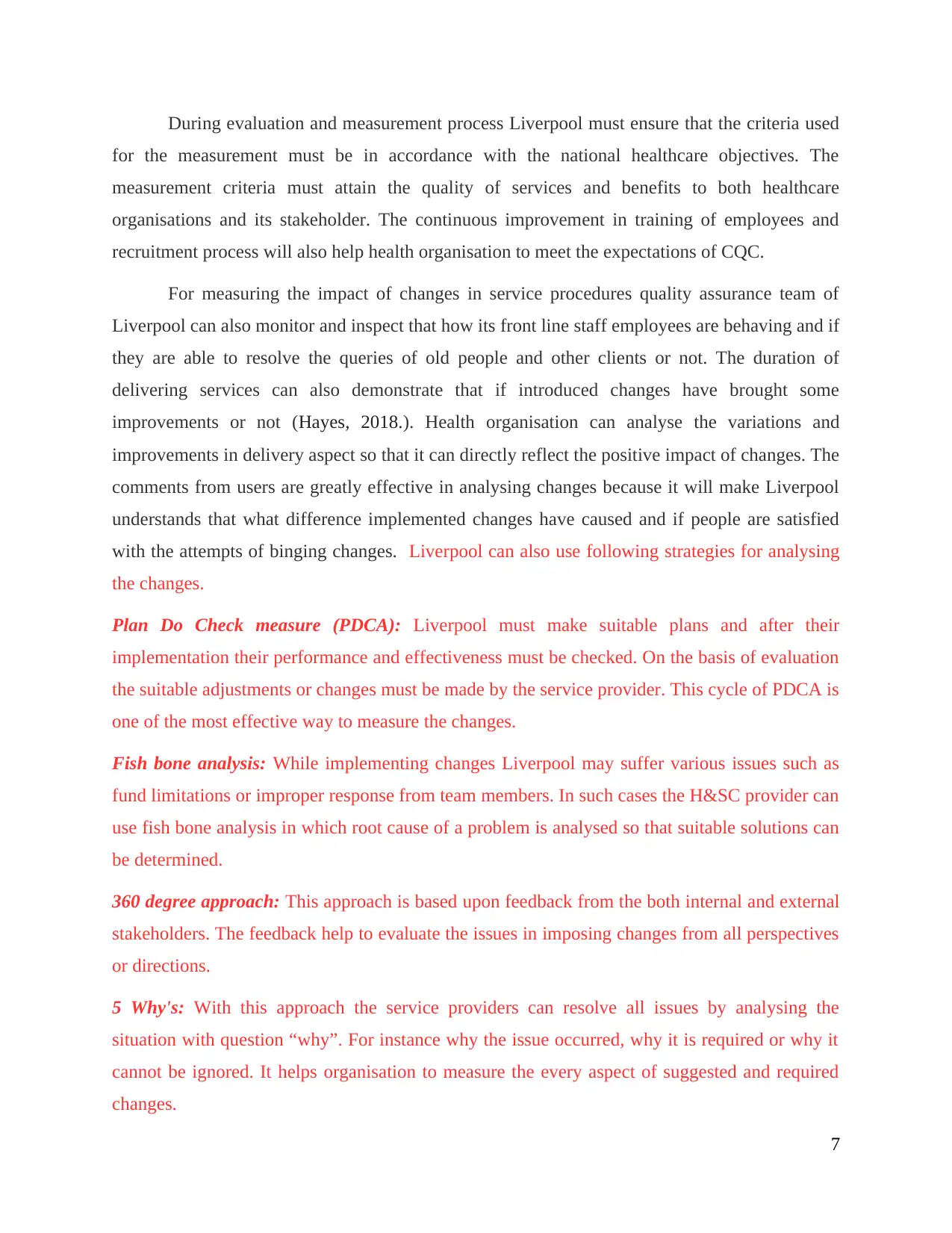
During evaluation and measurement process Liverpool must ensure that the criteria used
for the measurement must be in accordance with the national healthcare objectives. The
measurement criteria must attain the quality of services and benefits to both healthcare
organisations and its stakeholder. The continuous improvement in training of employees and
recruitment process will also help health organisation to meet the expectations of CQC.
For measuring the impact of changes in service procedures quality assurance team of
Liverpool can also monitor and inspect that how its front line staff employees are behaving and if
they are able to resolve the queries of old people and other clients or not. The duration of
delivering services can also demonstrate that if introduced changes have brought some
improvements or not (Hayes, 2018.). Health organisation can analyse the variations and
improvements in delivery aspect so that it can directly reflect the positive impact of changes. The
comments from users are greatly effective in analysing changes because it will make Liverpool
understands that what difference implemented changes have caused and if people are satisfied
with the attempts of binging changes. Liverpool can also use following strategies for analysing
the changes.
Plan Do Check measure (PDCA): Liverpool must make suitable plans and after their
implementation their performance and effectiveness must be checked. On the basis of evaluation
the suitable adjustments or changes must be made by the service provider. This cycle of PDCA is
one of the most effective way to measure the changes.
Fish bone analysis: While implementing changes Liverpool may suffer various issues such as
fund limitations or improper response from team members. In such cases the H&SC provider can
use fish bone analysis in which root cause of a problem is analysed so that suitable solutions can
be determined.
360 degree approach: This approach is based upon feedback from the both internal and external
stakeholders. The feedback help to evaluate the issues in imposing changes from all perspectives
or directions.
5 Why's: With this approach the service providers can resolve all issues by analysing the
situation with question “why”. For instance why the issue occurred, why it is required or why it
cannot be ignored. It helps organisation to measure the every aspect of suggested and required
changes.
7
for the measurement must be in accordance with the national healthcare objectives. The
measurement criteria must attain the quality of services and benefits to both healthcare
organisations and its stakeholder. The continuous improvement in training of employees and
recruitment process will also help health organisation to meet the expectations of CQC.
For measuring the impact of changes in service procedures quality assurance team of
Liverpool can also monitor and inspect that how its front line staff employees are behaving and if
they are able to resolve the queries of old people and other clients or not. The duration of
delivering services can also demonstrate that if introduced changes have brought some
improvements or not (Hayes, 2018.). Health organisation can analyse the variations and
improvements in delivery aspect so that it can directly reflect the positive impact of changes. The
comments from users are greatly effective in analysing changes because it will make Liverpool
understands that what difference implemented changes have caused and if people are satisfied
with the attempts of binging changes. Liverpool can also use following strategies for analysing
the changes.
Plan Do Check measure (PDCA): Liverpool must make suitable plans and after their
implementation their performance and effectiveness must be checked. On the basis of evaluation
the suitable adjustments or changes must be made by the service provider. This cycle of PDCA is
one of the most effective way to measure the changes.
Fish bone analysis: While implementing changes Liverpool may suffer various issues such as
fund limitations or improper response from team members. In such cases the H&SC provider can
use fish bone analysis in which root cause of a problem is analysed so that suitable solutions can
be determined.
360 degree approach: This approach is based upon feedback from the both internal and external
stakeholders. The feedback help to evaluate the issues in imposing changes from all perspectives
or directions.
5 Why's: With this approach the service providers can resolve all issues by analysing the
situation with question “why”. For instance why the issue occurred, why it is required or why it
cannot be ignored. It helps organisation to measure the every aspect of suggested and required
changes.
7
⊘ This is a preview!⊘
Do you want full access?
Subscribe today to unlock all pages.

Trusted by 1+ million students worldwide
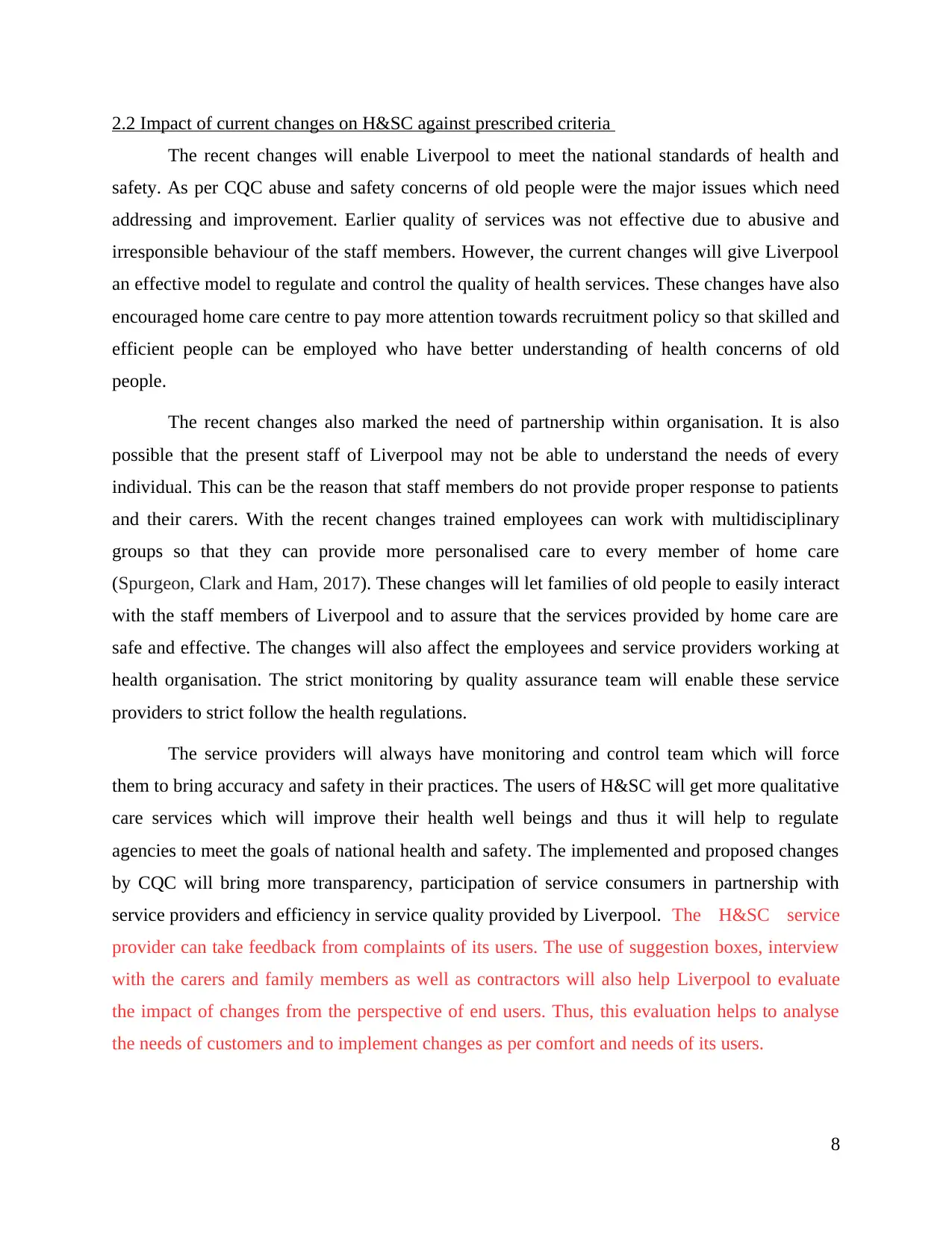
2.2 Impact of current changes on H&SC against prescribed criteria
The recent changes will enable Liverpool to meet the national standards of health and
safety. As per CQC abuse and safety concerns of old people were the major issues which need
addressing and improvement. Earlier quality of services was not effective due to abusive and
irresponsible behaviour of the staff members. However, the current changes will give Liverpool
an effective model to regulate and control the quality of health services. These changes have also
encouraged home care centre to pay more attention towards recruitment policy so that skilled and
efficient people can be employed who have better understanding of health concerns of old
people.
The recent changes also marked the need of partnership within organisation. It is also
possible that the present staff of Liverpool may not be able to understand the needs of every
individual. This can be the reason that staff members do not provide proper response to patients
and their carers. With the recent changes trained employees can work with multidisciplinary
groups so that they can provide more personalised care to every member of home care
(Spurgeon, Clark and Ham, 2017). These changes will let families of old people to easily interact
with the staff members of Liverpool and to assure that the services provided by home care are
safe and effective. The changes will also affect the employees and service providers working at
health organisation. The strict monitoring by quality assurance team will enable these service
providers to strict follow the health regulations.
The service providers will always have monitoring and control team which will force
them to bring accuracy and safety in their practices. The users of H&SC will get more qualitative
care services which will improve their health well beings and thus it will help to regulate
agencies to meet the goals of national health and safety. The implemented and proposed changes
by CQC will bring more transparency, participation of service consumers in partnership with
service providers and efficiency in service quality provided by Liverpool. The H&SC service
provider can take feedback from complaints of its users. The use of suggestion boxes, interview
with the carers and family members as well as contractors will also help Liverpool to evaluate
the impact of changes from the perspective of end users. Thus, this evaluation helps to analyse
the needs of customers and to implement changes as per comfort and needs of its users.
8
The recent changes will enable Liverpool to meet the national standards of health and
safety. As per CQC abuse and safety concerns of old people were the major issues which need
addressing and improvement. Earlier quality of services was not effective due to abusive and
irresponsible behaviour of the staff members. However, the current changes will give Liverpool
an effective model to regulate and control the quality of health services. These changes have also
encouraged home care centre to pay more attention towards recruitment policy so that skilled and
efficient people can be employed who have better understanding of health concerns of old
people.
The recent changes also marked the need of partnership within organisation. It is also
possible that the present staff of Liverpool may not be able to understand the needs of every
individual. This can be the reason that staff members do not provide proper response to patients
and their carers. With the recent changes trained employees can work with multidisciplinary
groups so that they can provide more personalised care to every member of home care
(Spurgeon, Clark and Ham, 2017). These changes will let families of old people to easily interact
with the staff members of Liverpool and to assure that the services provided by home care are
safe and effective. The changes will also affect the employees and service providers working at
health organisation. The strict monitoring by quality assurance team will enable these service
providers to strict follow the health regulations.
The service providers will always have monitoring and control team which will force
them to bring accuracy and safety in their practices. The users of H&SC will get more qualitative
care services which will improve their health well beings and thus it will help to regulate
agencies to meet the goals of national health and safety. The implemented and proposed changes
by CQC will bring more transparency, participation of service consumers in partnership with
service providers and efficiency in service quality provided by Liverpool. The H&SC service
provider can take feedback from complaints of its users. The use of suggestion boxes, interview
with the carers and family members as well as contractors will also help Liverpool to evaluate
the impact of changes from the perspective of end users. Thus, this evaluation helps to analyse
the needs of customers and to implement changes as per comfort and needs of its users.
8
Paraphrase This Document
Need a fresh take? Get an instant paraphrase of this document with our AI Paraphraser
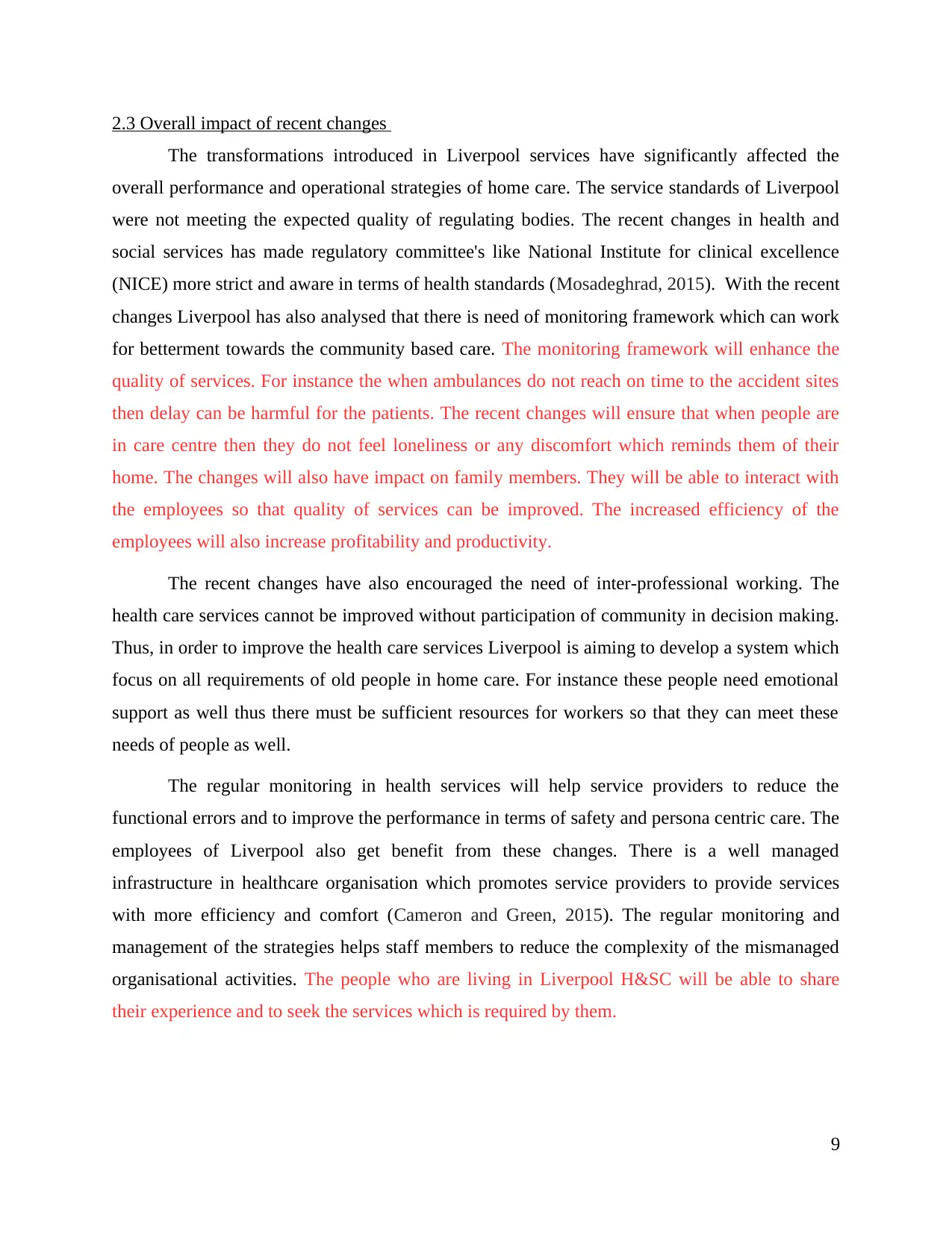
2.3 Overall impact of recent changes
The transformations introduced in Liverpool services have significantly affected the
overall performance and operational strategies of home care. The service standards of Liverpool
were not meeting the expected quality of regulating bodies. The recent changes in health and
social services has made regulatory committee's like National Institute for clinical excellence
(NICE) more strict and aware in terms of health standards (Mosadeghrad, 2015). With the recent
changes Liverpool has also analysed that there is need of monitoring framework which can work
for betterment towards the community based care. The monitoring framework will enhance the
quality of services. For instance the when ambulances do not reach on time to the accident sites
then delay can be harmful for the patients. The recent changes will ensure that when people are
in care centre then they do not feel loneliness or any discomfort which reminds them of their
home. The changes will also have impact on family members. They will be able to interact with
the employees so that quality of services can be improved. The increased efficiency of the
employees will also increase profitability and productivity.
The recent changes have also encouraged the need of inter-professional working. The
health care services cannot be improved without participation of community in decision making.
Thus, in order to improve the health care services Liverpool is aiming to develop a system which
focus on all requirements of old people in home care. For instance these people need emotional
support as well thus there must be sufficient resources for workers so that they can meet these
needs of people as well.
The regular monitoring in health services will help service providers to reduce the
functional errors and to improve the performance in terms of safety and persona centric care. The
employees of Liverpool also get benefit from these changes. There is a well managed
infrastructure in healthcare organisation which promotes service providers to provide services
with more efficiency and comfort (Cameron and Green, 2015). The regular monitoring and
management of the strategies helps staff members to reduce the complexity of the mismanaged
organisational activities. The people who are living in Liverpool H&SC will be able to share
their experience and to seek the services which is required by them.
9
The transformations introduced in Liverpool services have significantly affected the
overall performance and operational strategies of home care. The service standards of Liverpool
were not meeting the expected quality of regulating bodies. The recent changes in health and
social services has made regulatory committee's like National Institute for clinical excellence
(NICE) more strict and aware in terms of health standards (Mosadeghrad, 2015). With the recent
changes Liverpool has also analysed that there is need of monitoring framework which can work
for betterment towards the community based care. The monitoring framework will enhance the
quality of services. For instance the when ambulances do not reach on time to the accident sites
then delay can be harmful for the patients. The recent changes will ensure that when people are
in care centre then they do not feel loneliness or any discomfort which reminds them of their
home. The changes will also have impact on family members. They will be able to interact with
the employees so that quality of services can be improved. The increased efficiency of the
employees will also increase profitability and productivity.
The recent changes have also encouraged the need of inter-professional working. The
health care services cannot be improved without participation of community in decision making.
Thus, in order to improve the health care services Liverpool is aiming to develop a system which
focus on all requirements of old people in home care. For instance these people need emotional
support as well thus there must be sufficient resources for workers so that they can meet these
needs of people as well.
The regular monitoring in health services will help service providers to reduce the
functional errors and to improve the performance in terms of safety and persona centric care. The
employees of Liverpool also get benefit from these changes. There is a well managed
infrastructure in healthcare organisation which promotes service providers to provide services
with more efficiency and comfort (Cameron and Green, 2015). The regular monitoring and
management of the strategies helps staff members to reduce the complexity of the mismanaged
organisational activities. The people who are living in Liverpool H&SC will be able to share
their experience and to seek the services which is required by them.
9
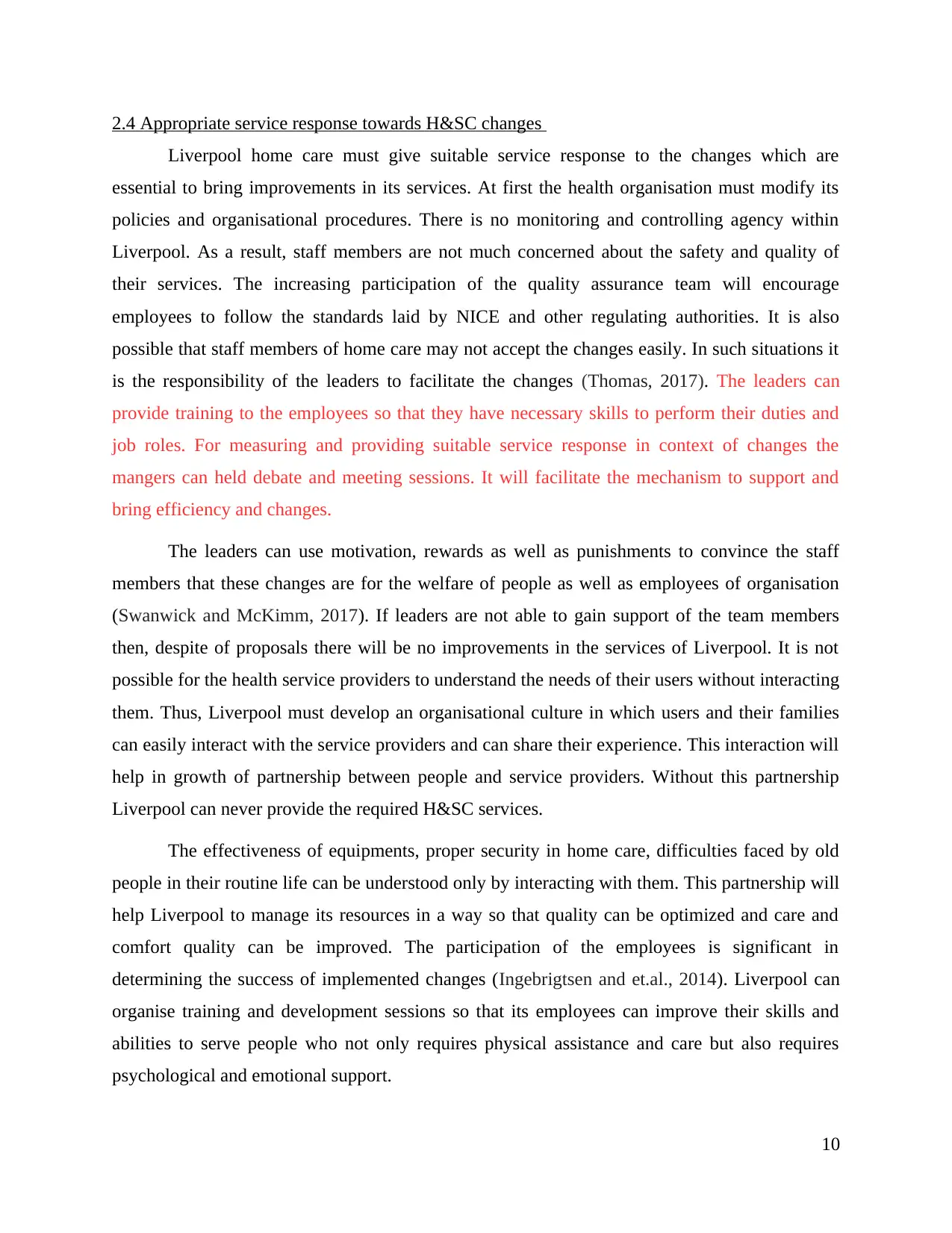
2.4 Appropriate service response towards H&SC changes
Liverpool home care must give suitable service response to the changes which are
essential to bring improvements in its services. At first the health organisation must modify its
policies and organisational procedures. There is no monitoring and controlling agency within
Liverpool. As a result, staff members are not much concerned about the safety and quality of
their services. The increasing participation of the quality assurance team will encourage
employees to follow the standards laid by NICE and other regulating authorities. It is also
possible that staff members of home care may not accept the changes easily. In such situations it
is the responsibility of the leaders to facilitate the changes (Thomas, 2017). The leaders can
provide training to the employees so that they have necessary skills to perform their duties and
job roles. For measuring and providing suitable service response in context of changes the
mangers can held debate and meeting sessions. It will facilitate the mechanism to support and
bring efficiency and changes.
The leaders can use motivation, rewards as well as punishments to convince the staff
members that these changes are for the welfare of people as well as employees of organisation
(Swanwick and McKimm, 2017). If leaders are not able to gain support of the team members
then, despite of proposals there will be no improvements in the services of Liverpool. It is not
possible for the health service providers to understand the needs of their users without interacting
them. Thus, Liverpool must develop an organisational culture in which users and their families
can easily interact with the service providers and can share their experience. This interaction will
help in growth of partnership between people and service providers. Without this partnership
Liverpool can never provide the required H&SC services.
The effectiveness of equipments, proper security in home care, difficulties faced by old
people in their routine life can be understood only by interacting with them. This partnership will
help Liverpool to manage its resources in a way so that quality can be optimized and care and
comfort quality can be improved. The participation of the employees is significant in
determining the success of implemented changes (Ingebrigtsen and et.al., 2014). Liverpool can
organise training and development sessions so that its employees can improve their skills and
abilities to serve people who not only requires physical assistance and care but also requires
psychological and emotional support.
10
Liverpool home care must give suitable service response to the changes which are
essential to bring improvements in its services. At first the health organisation must modify its
policies and organisational procedures. There is no monitoring and controlling agency within
Liverpool. As a result, staff members are not much concerned about the safety and quality of
their services. The increasing participation of the quality assurance team will encourage
employees to follow the standards laid by NICE and other regulating authorities. It is also
possible that staff members of home care may not accept the changes easily. In such situations it
is the responsibility of the leaders to facilitate the changes (Thomas, 2017). The leaders can
provide training to the employees so that they have necessary skills to perform their duties and
job roles. For measuring and providing suitable service response in context of changes the
mangers can held debate and meeting sessions. It will facilitate the mechanism to support and
bring efficiency and changes.
The leaders can use motivation, rewards as well as punishments to convince the staff
members that these changes are for the welfare of people as well as employees of organisation
(Swanwick and McKimm, 2017). If leaders are not able to gain support of the team members
then, despite of proposals there will be no improvements in the services of Liverpool. It is not
possible for the health service providers to understand the needs of their users without interacting
them. Thus, Liverpool must develop an organisational culture in which users and their families
can easily interact with the service providers and can share their experience. This interaction will
help in growth of partnership between people and service providers. Without this partnership
Liverpool can never provide the required H&SC services.
The effectiveness of equipments, proper security in home care, difficulties faced by old
people in their routine life can be understood only by interacting with them. This partnership will
help Liverpool to manage its resources in a way so that quality can be optimized and care and
comfort quality can be improved. The participation of the employees is significant in
determining the success of implemented changes (Ingebrigtsen and et.al., 2014). Liverpool can
organise training and development sessions so that its employees can improve their skills and
abilities to serve people who not only requires physical assistance and care but also requires
psychological and emotional support.
10
⊘ This is a preview!⊘
Do you want full access?
Subscribe today to unlock all pages.

Trusted by 1+ million students worldwide
1 out of 19
Related Documents
Your All-in-One AI-Powered Toolkit for Academic Success.
+13062052269
info@desklib.com
Available 24*7 on WhatsApp / Email
![[object Object]](/_next/static/media/star-bottom.7253800d.svg)
Unlock your academic potential
Copyright © 2020–2025 A2Z Services. All Rights Reserved. Developed and managed by ZUCOL.





